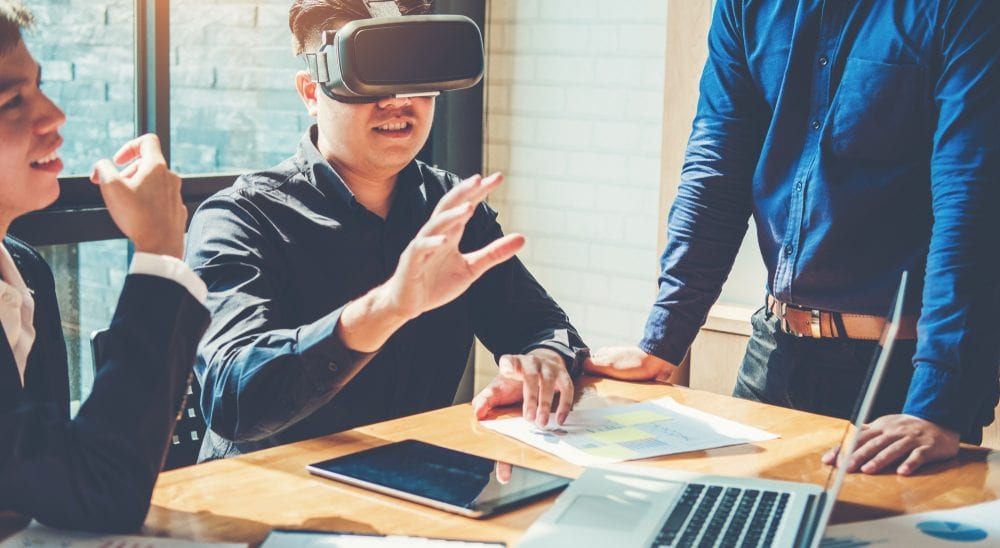Transforming the learning experience through VR

Tim Massey, Engineering & VR Product Manager, Vicon shows us how VR is being used by forward-thinking businesses worldwide to improve their corporate training and why it’s here to stay for the years to come.
Virtual reality (VR) technologies were first introduced by the gaming industry over 20 years’ ago in order to completely transform the way we play video games — allowing gamers to go beyond the traditional 2D screen and into a virtual world to experience immersion like never before.
Ten years later and some of the world’s biggest players in the gaming industry launched next-generation VR headsets that sparked a new wave of development.
While the technology is still playing a large role within the gaming space, the use of VR is now extending into several different industries. In fact, the use of the technology for corporate training is now seen as one of the fastest growing applications.
The interest in VR for corporate training is driven by our growing understanding of exactly how virtual experiences can support and enhance the learning process. Studies have shown that people learn better and improve the amount of information they recall through virtual environments over 2D computer screens or hand-held tablets.
For example, researchers at the University of Maryland conducted a study where 40 participants were asked to perform a task using a VR headset and repeated the same task with a 2D desktop PC or tablet. When participants used VR headsets, the results uncovered an 8.8% improvement in memory performance.
Saving lives
One particularly compelling example of how VR is being used to train employees is Walmart’s use of the technology.
The US supermarket giant provides its employees with active shooter training as part of its Walmart Academy training curriculum — designed to provide its staff with the knowledge and skills required to safely handle a potentially deadly situation.
Through VR headsets, employees are able to enter a real-life scenario that would usually be impossible to recreate. This enables staff to monitor the performance of users, including their accuracy of holding a gun and their ability to negotiate — allowing them to provide constructive feedback where necessary.
A mass shooting which took place at a Texas-based Walmart last year meant the store’s employees were put to the test. While the tragedy unfortunately meant lives were lost, the retailer’s active shooter VR training prevented the number of deaths from being even higher, with staff quickly responding to the situation and handling it as best as possible.
Tap into emotions
The key to the value of VR in training environments is exactly the same as in gaming – immersion. Although the Walmart example only involved a simple ‘seated’ VR experience, it shows just how powerful the additional immersion a VR headset can deliver. However, with a seated experience there are clearly certain restrictions when it comes to providing full immersion, and therefore the most effective training experiences possible.
Emotion has a huge influence on the cognitive processes in humans — including perception, attention, learning and memory. But it also has a particularly strong influence on attention too, especially when it comes to motivating action and behaviour.
There’s no doubt that seated VR experiences can be highly effective for making scenarios more believable. However, the experience may not be quite real enough to be able to tap into our emotions and provide the most efficient learning outcome.
So how can we ensure training is as immersive and believable as possible?
The LBE opportunity
Location-based entertainment (LBE) — a form of entertainment tied to a particular location outside of the home, including theme parks and large-scale arcades — allows users to physically interact with one another in an immersive environment. This method – using full body tracking – typically provides much richer and engaging experiences over traditional seated VR experiences.
Although LBE is becoming increasingly popular for gaming experiences, businesses are starting to reap the benefits of LBE-developed technology for training scenarios.
Unlike traditional VR methods, the technology can support a larger number of simultaneous users in bigger venues, and enables extremely accurate tracking to provide more realistic, immersive VR experiences.
Today, LBE technology is being used within safety-first organisations including the military and emergency services where employees are often faced with potentially life-threatening situations. Through the use of immersive full body motion tracking, staff are able to re-create such scenarios in the most life-like way possible to make sure they are fully prepared if a dangerous scenario should occur.
A good example is the New York Police Department (NYPD), which is using LBE for active shooter training. Unlike the VR training for Walmart employees, NYPD staff are able to actually feel and shoot with real weapons — while real participants or actors can play both sides to add unpredictability.
The future ahead
As it stands today, LBE technology is mostly being used across safety-critical applications. However, this powerful training tool is likely to receive higher traction across a wider range of industries in the years to come.
For example, through LBE training, manufacturers can train their workforce with virtually simulated equipment in a lifelike environment without the risk of any downtime of productive equipment. By the time employees are fully trained to use the equipment and operate a real production line, they’re more prepared and familiar with whatever physical activity is required — resulting in fewer interruptions and potential mistakes within the production process.
Whether it is LBE-based or more traditional headset-based, it is clear that VR training is here to stay. However, it’s important for businesses to understand what they are trying to achieve from training before making a decision on what implementation is best suited for them. Traditional VR training is and will continue to help millions of employees across the globe, but for those looking for the most immersive and believable scenarios, full body immersion is the way forward.
